
SAFARI
Users
Fish Sauce
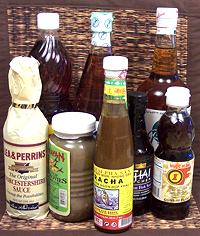 [Nam Pla (Thai); Nuoc Mam (Viet), Patis (Philippine); Garum,
Liquamen, Muria, Allec (Roman); Garos (Greek)]
[Nam Pla (Thai); Nuoc Mam (Viet), Patis (Philippine); Garum,
Liquamen, Muria, Allec (Roman); Garos (Greek)]
Fish sauce is essential to several cuisines, particularly those of Vietnam and Thailand today and of the Roman Empire. Fish sauce is made by packing small fish or fish blood and innards or a combination of both into large barrels or jars layered with salt and setting the barrels out in the hot sun for around a year. The fish is digested by its own digestive enzymes and a clear salty liquid is eventually drained off and bottled. The paste left in the bottom of the barrels is also bottled and sold as a different kind of fish sauce. For types and culinary details see our Fish Sauce page.
Subst: there is no true substitute for fish sauce. If you
are a strict vegetarian a fermented yellow bean sauce is about as close
as you can get. Lacking both you must resort to just salt.
Fish - Dried, Salted & Smoked
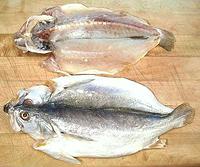
For thousands of years, fish have been dried, salted and smoked as a
means of preserving a very perishable product. These products remain
important to all countries worldwide that have a seacoast, and some
that don't. Even in regions where freezing and fast transportation make
such preservation unnecessary, they are still in high demand because of
the unique flavors they impart to many recipes. For types and culinary
details see our
Fish - Dried, Salted &
Smoked page.
Smoke Dried Fish
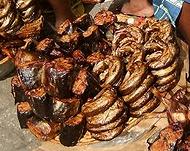 In West Africa and other regions without widely available refrigeration,
fish is smoked until very dry. This product is very different from our
Western smoked fish, which still need refrigeration. Fish that have gone
through this smoking are tough, brittle, and need extensive soaking
before use in recipes. For details and examples see our
Smoke Dried Fish page.
In West Africa and other regions without widely available refrigeration,
fish is smoked until very dry. This product is very different from our
Western smoked fish, which still need refrigeration. Fish that have gone
through this smoking are tough, brittle, and need extensive soaking
before use in recipes. For details and examples see our
Smoke Dried Fish page.
Fish - Canned, Pickled, etc.

Some fish are particularly suitable for processing in a wide variety of ways.
Anchovies:
Canned and Dried
Herrings /
Sardines: Canned, Pickled, Smoked, Dried, etc.
Sprats
Canned, Smoked, etc.
Fish Eggs & Caviar
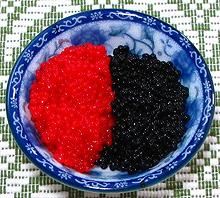
Fish eggs (roe) have been on the human menu for thousands of years,
prepared and eaten in various ways. According to the United Nations,
other international groups, and the U.S. Customs Service, the term
"Caviar" can only be used for the roe of Sturgeons and Paddlefish.
Despite this, in common usage, the eggs of other fish eggs that
have been salted and aged as sturgeon caviar is, are often also
called "caviar", clarified with the name of the fish the eggs came
from. For types and culinary
details see our Fish Eggs &
Caviar page.
Surimi & Surimi Products
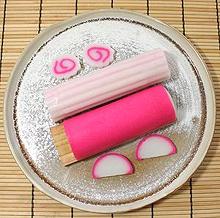
Fish Cake, Kamaboko, Artificial Crab meat, Fish Balls, Surimi Baby Eels and various other products. Surimi is white fleshed fish, cleaned, deboned, and ground to paste.
Surimi is also made commercially and in homes, used to make Seafood
Patties and other cooked items. Some recipes will be found in our recipe
pages.
Details and Cooking.
Shark Fin - Artificial
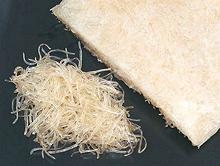 Because real Shark Fin is illegal in civilized regions, due to the horrid
inhumane practices of the East Asian shark fin industry, artificial shark
fin has been made available, and is much easier to use then the real thing.
Unfortunately, while there's little actual difference, it is not
suitable for the famous Shark Fin Soup offered at Chinese banquets - it's
not nearly costly enough. "Incredibly high cost, 1000 times enjoyment",
old Chinese saying (also valid for Japan). For details see our
Shark Fin - Real and Artificial
page.
Because real Shark Fin is illegal in civilized regions, due to the horrid
inhumane practices of the East Asian shark fin industry, artificial shark
fin has been made available, and is much easier to use then the real thing.
Unfortunately, while there's little actual difference, it is not
suitable for the famous Shark Fin Soup offered at Chinese banquets - it's
not nearly costly enough. "Incredibly high cost, 1000 times enjoyment",
old Chinese saying (also valid for Japan). For details see our
Shark Fin - Real and Artificial
page.

